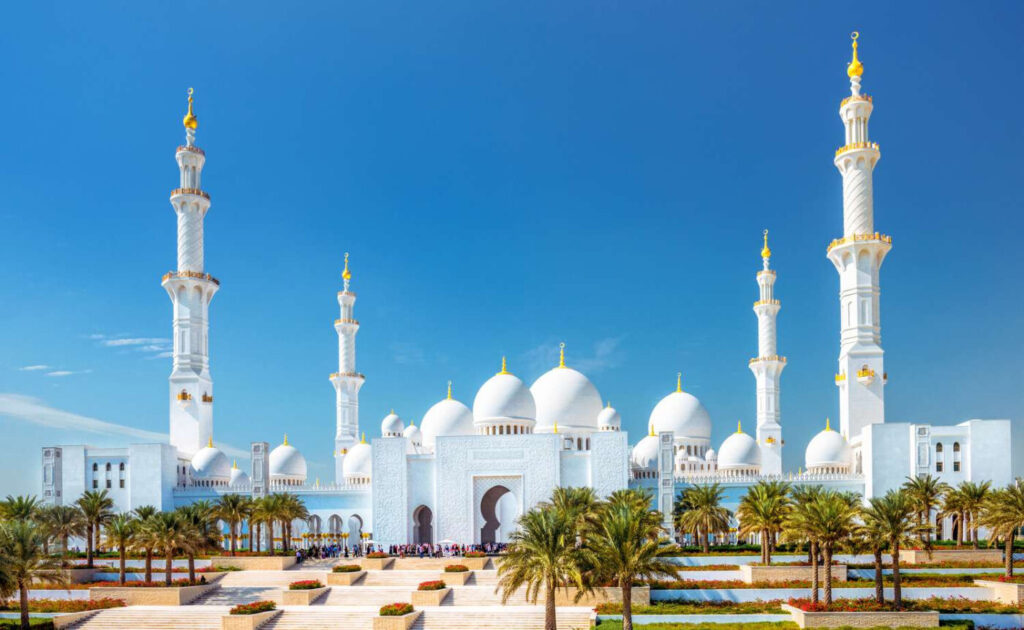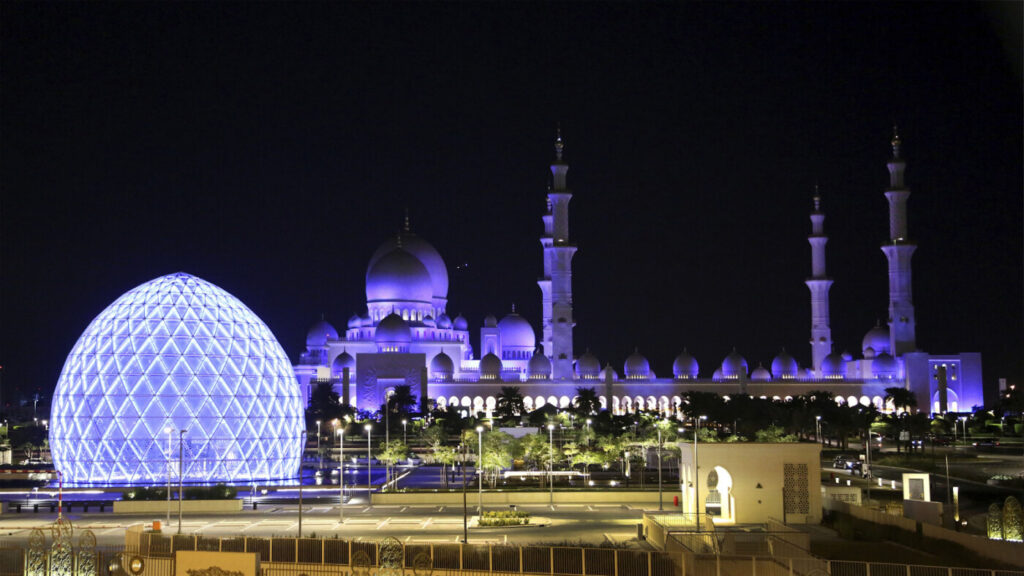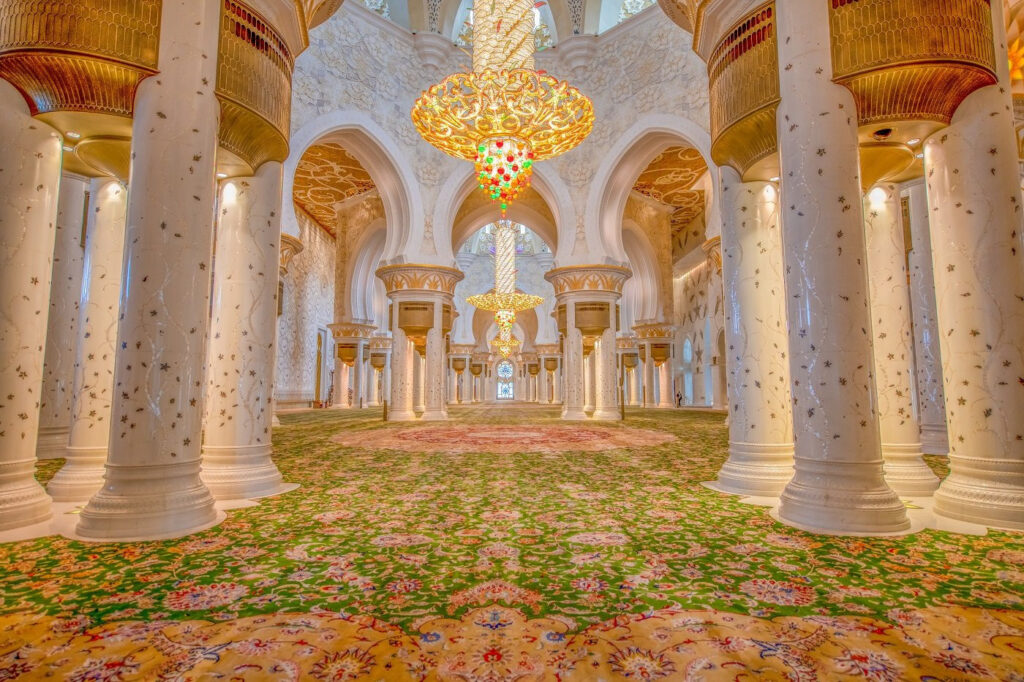
It was officially opened during the month of Ramadan in 2007. This is not only a place of worship and education for Muslims, but also a popular tourist destination that welcomes all.
Construction of the Mosque lasted more than 10 years. They built it with all the luxury typical of the Middle East. The main color in the decoration of the Mosque is white.
READ: New Projects from DAMAC Properties and OMNIYAT: DAMAC Casa and Vela Viento
In Arab culture, it symbolizes decency, honesty, purity, and prosperity. Sheikh Zayed’s favorite color is green, which also adorns the mosque. The location where his ashes are buried is marked by continuous chanting of the Quran.
The mosque can accommodate up to 40 thousand people, and 7 thousand of them can fit in the main prayer hall. Each of the two adjacent rooms, reserved for women, can hold up to 1,500 people.

The idea of building the Mosque appeared in the late 1980s, the site was chosen in the mid-1990s, and construction began only in 1996. The construction process involved not only local specialists but also engineers from the USA, and craftsmen from India and Greece. But soon the work was suspended – the Department of Public Works and the contractors could not reach an agreement while resolving ongoing issues. The main volumes of the Mosque were ready by May 2002, and fully completed in 2007.
In plan, the Mosque is a rectangle. The total area of the Muslim shrine is 22,412 m²; its exterior is decorated with an arcade consisting of 1096 exquisite columns. They are covered with marble panels inlaid with semi-precious stones: lapis lazuli, amethyst, mother of pearl, and red agate.
READ: Important History: UAE’s Ruling Families
The Mosque’s main entrance door is 12.2m tall, 7m wide, and weighs 2.2 tons, made entirely of glass.
The 82 domes in the outer row vary in shape and size but are all clad in white marble with gold and glass mosaics. The largest of the domes rises in the center of the main prayer hall.
At the corners of the Mosque, there are minarets – prayer towers, from where the muezzin calls believers to prayer. Their height is 107 meters. Each minaret has 3 geometric volumes.
The lower one is a parallelepiped, at the base of which is a square – it is made in the Moroccan style, then there is an octagon in the Mamluk style, and the third volume is a cylinder. The minaret is crowned with a lantern covered with a mosaic of glass and gold.
The Sheikh Zayed Grand Mosque is imposing at night. 22 light towers with spotlights illuminate the Muslim shrine. Moreover, the color of the light depends on the phase of the moon and changes every day. This lighting system was created by architects Jonathon Speirs and Maer. Thanks to innovative technologies, the facility consumes little energy.
Outside the Mosque there are artificial lakes and canals with a total area of 7,874 m². The surfaces are adorned with blue tiles that create a magical atmosphere with the Mosque’s reflection in the evenings and at night.
Sahan, or courtyard, is an open-air area used for prayer on major holidays: the month of Ramadan, the holiday of breaking the fast (Eid al-Fitr), and the holiday of sacrifice (Il al-Adha). This courtyard at the Sheikh Zayed Grand Mosque covers 17,400 m² and can accommodate approximately 31,000 worshipers.

Interesting fact: The Sheikh Zayed Grand Mosque has the largest carpet in the world on the floor!
Its area is 5,627 m² and its weight is 47 tons. It was made by the Iran carpet company, using 35 tons of wool and 12 tons of cotton. Iranian artist Ali Khaligi was the ideological developer: this giant carpet was created according to his sketch. The design took 8 months and the weaving took 12 months. About 1,200 weavers, 20 technical groups, and 30 specialists worked on its creation. The result of the work was a carpet of 2,268,000 knots. The cost of such an Arab treasure is approximately 8.2 million dollars.
Another miracle of beauty – German chandeliers decorated with gold leaf and Austrian Swarovski crystals are hung in the halls of the Mosque. The chandelier in the Great Hall was considered the largest in the world – it was 10 m in diameter and 15 m in height. But in 2010, a larger chandelier appeared in Qatar.
Decorating the wall is the Kufic script with the 99 names of Allah. They are lined with gold and glass mosaics and illuminated with fiber optic lighting.
READ: Bur Dubai: One of the Most Interesting and Ultra-Modern Neighborhoods in Dubai
Also worthy of attention is the podium – the minbar, where the imam preaches on Fridays. It is located to the right of the mihrab, a wall niche oriented towards Mecca. The grandstand has 11 steps, it is all dotted with floral motifs and cedar shells with inlays of glass mosaics, mother-of-pearl, and white gold.